Black History Month is the opportunity to recognize the many accomplishments of Black Americans. It is from this foundation of sacrifices that we secure our place in American history. It is from this sacrifice and struggle we carve out our place in society, and it is from this sacrifice we continue to strive to be a better people. It is the sacrifices of people like Ralph Abernathy, Stokely Carmichael, Dr. Martin L. King Jr., Malcolm X, Rosa Parks, Dick Gregory, and Jo Ann Robinson to name a few. We are very familiar with these icons of civil rights, but that is not the only thing the month celebrates. The month also celebrates the achievements of the many brave soldiers and airman, who endured just as much discrimination and prejudice while in service to this country, and made just as great sacrifices for the betterment of their race. The fact that there has been a Black presence in every military the U’S’ has ever been in; from the Revolutionary War to the Civil War until now; is a matter of pride for those currently serving in defense of their country.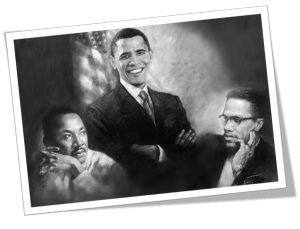
History tells us that of the British during the Revolutionary War tried recruiting runaway slaves to fight for them by offering them their freedom, and the black soldiers who served in the northern militias against them, In the War of 1812 black units fought, and one militia unit in particular; The Louisiana Battalion of Free Men of Color. Dubbing themselves the “Men of Bronze”, they fought under General Andrew Jackson in the Battle of New Orleans. In the Civil War, there were 163 all black units that served in the Union Army and Navy. Confederate Congress even enacted a statue to allow Blacks to serve. It is highlights like that and other examples that kept young men joining up to serve, even though the military reflected society in its treatment of blacks. The men were not ashamed to fulfill their patriotic duty, and continued on through the First World War, where 350.000 Blacks served. Although most were relegated to support roles, there were some who saw action overseas. It wasn’t until after the Second World War that integration came to the military, but the Black soldier would distinguish himself even without fame or recognition, but for defense of family and country. In modern times, the exploits of one of the most recognized units of black soldiers is chronicled by Max Brooks of World War Z fame in the upcoming graphic novel entitled “The Harlem Hellfighters” (April 2014). The book tells the story of the 369th Infantry Regiment. The regiment was first created in 1916 as the 15th New York National Guard Infantry; it fought with distinction in both WWI and WWII. Its uniqueness came from the fact that it was truly and all black unit with all black officers and non-commissioned officers. The regiment fought in Italy and was crucial in the liberation of Rome. The regiment did not desegregate until after WWII.
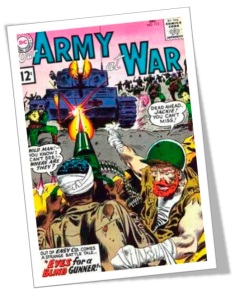 It was shortly after WWII that we find the first comic published that included this new look the military was sporting. The character’s name was Jackie Johnson and he was a member of Sgt. Rock’s Easy Co. The name of the book was, Our Army at War, the character is credited as being the first non-stereotyped black to appear in comics. Easy Co. was a diverse group of soldiers who represented the unit that Sgt. Rock lead, but Sgt. Rock was the main character and who the book was really about. Issue #160 tells some of Jackie’s background story. In the issue it tells how Jackie was a heavyweight champ who lost his belt to a Nazi. Jackie and some of his fellow soldiers get captured, and the Nazi who defeated him was one of the guards. Jackie is granted a rematch but is told to let the guard beat him mercilessly or they would kill his friends. Jackie refuses to give in. Jackie was a member of Easy Co. for their entire run, and deserves to be highlighted for his historic place in Black History.
It was shortly after WWII that we find the first comic published that included this new look the military was sporting. The character’s name was Jackie Johnson and he was a member of Sgt. Rock’s Easy Co. The name of the book was, Our Army at War, the character is credited as being the first non-stereotyped black to appear in comics. Easy Co. was a diverse group of soldiers who represented the unit that Sgt. Rock lead, but Sgt. Rock was the main character and who the book was really about. Issue #160 tells some of Jackie’s background story. In the issue it tells how Jackie was a heavyweight champ who lost his belt to a Nazi. Jackie and some of his fellow soldiers get captured, and the Nazi who defeated him was one of the guards. Jackie is granted a rematch but is told to let the guard beat him mercilessly or they would kill his friends. Jackie refuses to give in. Jackie was a member of Easy Co. for their entire run, and deserves to be highlighted for his historic place in Black History.
Jackie’s inclusion was no accident. There were approximately 125,000 Black soldiers overseas in WWII, and those blacks weren’t just cooks and truck drivers. There were 3 all-Black divisions created. All saw some action, but only one saw extensive combat. There were two Calvary Divisions, with the 9th and 10th divisions known as the Buffalo Soldiers; a name they retained from the Indian Wars, in which the all black Calvary regiments, along with the 24th and 25th Infantry regiments, fought the Indians. There was also the famous Tuskegee Airman, which was created due to the Army Air Corps refusal to accept any blacks, because it didn’t want to create separate facilities for the blacks to use.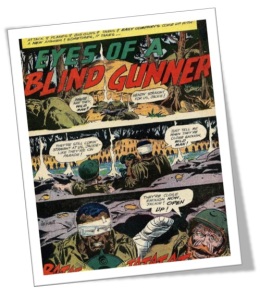 The aforementioned Sgt. Rock, while featured in his own comic, had two issues in 1985 (#405 and #406) which celebrated the participation of blacks in WWII, with issue #406 dedicated to the Tuskegee Airman. In 1943, recreational facilities were desegregated, but full desegregation of the military had not come yet. Then, in December of 1944, blacks were allowed to pick up weapons and fight during the Battle of the Bulge. This went a long way in helping the desegregation movement. The black soldier continued to dispel myths and stereotypes to prove him worthy of the equality that was slowly coming, but still recognized that changing the mindset of a people wouldn’t be that easy.
The aforementioned Sgt. Rock, while featured in his own comic, had two issues in 1985 (#405 and #406) which celebrated the participation of blacks in WWII, with issue #406 dedicated to the Tuskegee Airman. In 1943, recreational facilities were desegregated, but full desegregation of the military had not come yet. Then, in December of 1944, blacks were allowed to pick up weapons and fight during the Battle of the Bulge. This went a long way in helping the desegregation movement. The black soldier continued to dispel myths and stereotypes to prove him worthy of the equality that was slowly coming, but still recognized that changing the mindset of a people wouldn’t be that easy.
Although the military was segregated at that time, it didn’t stop creators Stan Lee and Jack Kirby when it came to creating their own WWII saga. In creating their war story, they developed a character who integrated his unit well before the military actually integrated the armed forces. In May of 1963 Marvel published its war comics series Sgt. Fury and his Howling Commandos. Included in as a cast member we find one of the first black comic characters in mainstream comics and the first black marvel character. The young man’s name is Gabriel “Gabe” Jones. When the cover of the 1st issue was sent to the colorist, as the story goes, he thought the color of Jones was wrong and made him white! Born in Harlem, Jones mastered the trumpet as a kid, even garnering lessons from the great Louis Armstrong. 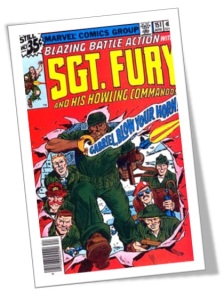 As he grew, Gabe met another Jazz musician who played the drums named Danny “Drummer” Bellaman. The two both enlisted into the military, and were both noticed by Army intelligence which enabled Gabe to receive special training, particularly in German classical music possibly to use in covert missions. Jones was hand-picked by Captain Sam Sawyer to serve under Nick Fury in the First Attack Squad, better known as the Howling Commandos, where he distinguished himself as both a musician and a soldier. He reunited with his friend Danny towards the end of the war, but it was only to see him sacrifice himself. Jones stayed with Fury and the Commandos, hunting down Nazi war criminals, and reenlisted during the Korean War to serve with the commandos. In the Black Panther/Captain America limited series, “Flags of Our Fathers” by Reginald Hudlin, we see the first meeting of Gabe Jones and Captain America, and see the special place Jones is bestowed by the then ruler of Wakanda, Azzuri. The portrayal of Jones is accurate in how a black soldier would feel in that circumstance. Jones expresses pride in not only being able to fight, but also being the first black to fight in the war. When Sgt. Fury asks him to get close to the Black Panther to gain information or even some vibranium, Jones questions to himself whether he is asking because he is black. Jones follows orders, but in the end does what he feels is right. Jones has a long career with S.H.I.E.L.D., even helping with the formation and start up of it, and dies will in service to it.
As he grew, Gabe met another Jazz musician who played the drums named Danny “Drummer” Bellaman. The two both enlisted into the military, and were both noticed by Army intelligence which enabled Gabe to receive special training, particularly in German classical music possibly to use in covert missions. Jones was hand-picked by Captain Sam Sawyer to serve under Nick Fury in the First Attack Squad, better known as the Howling Commandos, where he distinguished himself as both a musician and a soldier. He reunited with his friend Danny towards the end of the war, but it was only to see him sacrifice himself. Jones stayed with Fury and the Commandos, hunting down Nazi war criminals, and reenlisted during the Korean War to serve with the commandos. In the Black Panther/Captain America limited series, “Flags of Our Fathers” by Reginald Hudlin, we see the first meeting of Gabe Jones and Captain America, and see the special place Jones is bestowed by the then ruler of Wakanda, Azzuri. The portrayal of Jones is accurate in how a black soldier would feel in that circumstance. Jones expresses pride in not only being able to fight, but also being the first black to fight in the war. When Sgt. Fury asks him to get close to the Black Panther to gain information or even some vibranium, Jones questions to himself whether he is asking because he is black. Jones follows orders, but in the end does what he feels is right. Jones has a long career with S.H.I.E.L.D., even helping with the formation and start up of it, and dies will in service to it.
In Robert Morales’ book, Captain America: Truth, we are told the story of Isaiah Bradley and the segregated Army battalion he belonged to, which was experimented on with the same Super Soldier Formula that created Captain America. The serum was perfected using the men before it was given to Steve Rogers. Although Bradley wasn’t the lone survivor of the test, he was the only one that remained alive. In all, there were seven survivors of the test. The Army enlisted several hundred men, but only used a few of them, and killed the rest, initiating a big cover-up. The Sgt. of the unit, respectfully called Sarge, that Bradley was a member of, is a WWI veteran, and when asked which the biggest battle he had been in was, relates the story of the “Red Summer” which was a riot between Black soldiers and white civilians. One of the unit dies on the way to the first mission. When the unit goes on its first mission, 3 are killed. 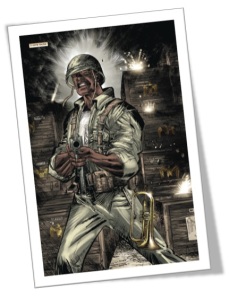 In the process of waiting for the new American “secret weapon”, Captain America, whose ship was delayed in the ocean due to increment weather, tempers flared between two of the remaining members and the racist Sgt. that was present, and both were killed. Bradley, although injured during the fight, decided that he would undertake the mission alone. .He took the uniform that was to be worn by Steve Rogers and went on the mission Rogers was supposed to lead the entire super soldier unit on. He was captured and eventually freed by the Nazi’s to the French Resistance, which got him passage back to the states. After arriving back in the states, Bradley was jailed and court-martialed for stealing Captain America’s uniform. Bradley had been reported dead in the cover up to his wife, but she fought the military because she didn’t believe them. When her husband arrived back in the states, she continued her fight for his freedom.
In the process of waiting for the new American “secret weapon”, Captain America, whose ship was delayed in the ocean due to increment weather, tempers flared between two of the remaining members and the racist Sgt. that was present, and both were killed. Bradley, although injured during the fight, decided that he would undertake the mission alone. .He took the uniform that was to be worn by Steve Rogers and went on the mission Rogers was supposed to lead the entire super soldier unit on. He was captured and eventually freed by the Nazi’s to the French Resistance, which got him passage back to the states. After arriving back in the states, Bradley was jailed and court-martialed for stealing Captain America’s uniform. Bradley had been reported dead in the cover up to his wife, but she fought the military because she didn’t believe them. When her husband arrived back in the states, she continued her fight for his freedom.
Morales’ book, while paying homage to the Black servicemen who served in defense of their country, is full of historical facts concerning Blacks and WWII. and also sheds light on the attitude of the military toward blacks during the beginning of the war, and by the white enlisted men, and during the course of the war. The book opens up with Isaiah and his wife attending Negro Week at the World’s Fair in 1940, and after Isaiah enlists, he talks about the “Double V” campaign by the NAACP. 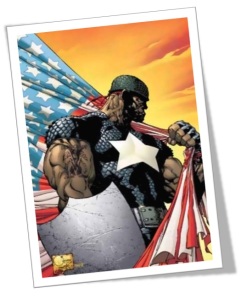 The Double V campaign was seen as the start of the civil rights movement, and was the invention of popular newspaper the Pittsburg Courier stood for a victory sign against enemies without and a victory sign against enemies within, with the Courier coming up with and emblem to go with the slogan. The massacre of the black troops stem from urban legends of 1200 black soldiers from the 364th Infantry Regiment stationed in Mississippi being executed for being agitators. Although the claim it was investigated, it proved false, and likely spurned by actual race riots occurring during WWII and the Army’s denials of similar massacres that occurred in the Korean War involving civilians that decades later were proved to be true. The “Red Summer” that Sarge spoke about is based on the riots that occurred in Houston Texas involving the 24th Infantry, which claimed the lives of 4 soldiers and 16 white civilians, including 2 local law enforcement officers. The incident was sparked by the beating of a black woman, and then in turn, the beating and arrest of two black soldiers. The first was beaten and arrested for interfering with the police who were beating the half-naked black woman in the streets after they drug her outside her residence. The second person was arrested because he came to inquire about the first. The second person was released and sent back to camp, and upon his arrival, his beaten and disheveled look incited approx.
The Double V campaign was seen as the start of the civil rights movement, and was the invention of popular newspaper the Pittsburg Courier stood for a victory sign against enemies without and a victory sign against enemies within, with the Courier coming up with and emblem to go with the slogan. The massacre of the black troops stem from urban legends of 1200 black soldiers from the 364th Infantry Regiment stationed in Mississippi being executed for being agitators. Although the claim it was investigated, it proved false, and likely spurned by actual race riots occurring during WWII and the Army’s denials of similar massacres that occurred in the Korean War involving civilians that decades later were proved to be true. The “Red Summer” that Sarge spoke about is based on the riots that occurred in Houston Texas involving the 24th Infantry, which claimed the lives of 4 soldiers and 16 white civilians, including 2 local law enforcement officers. The incident was sparked by the beating of a black woman, and then in turn, the beating and arrest of two black soldiers. The first was beaten and arrested for interfering with the police who were beating the half-naked black woman in the streets after they drug her outside her residence. The second person was arrested because he came to inquire about the first. The second person was released and sent back to camp, and upon his arrival, his beaten and disheveled look incited approx. 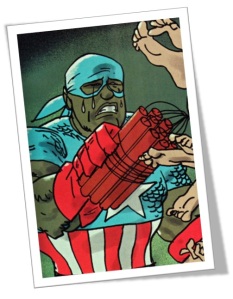 150 soldiers to arms. The soldiers marched to Houston and were met by armed citizens and local law enforcement. 13 soldiers were arrested, tried, court-martialed, and hanged for crimes relating to the incident. Morales also draw from history in his portrayal of the Nazi camp and the imprisoned Jews, as well as from the attitude of Hitler towards Blacks. The “secret experiment” conducted by the military echoes the Tuskegee experiment, which President Clinton apologized for in 1997, as well as other clandestine experiments that have been documented as being carried out by an unsuspecting American populace. The book is a great collector’s item for all black comic book fans.
150 soldiers to arms. The soldiers marched to Houston and were met by armed citizens and local law enforcement. 13 soldiers were arrested, tried, court-martialed, and hanged for crimes relating to the incident. Morales also draw from history in his portrayal of the Nazi camp and the imprisoned Jews, as well as from the attitude of Hitler towards Blacks. The “secret experiment” conducted by the military echoes the Tuskegee experiment, which President Clinton apologized for in 1997, as well as other clandestine experiments that have been documented as being carried out by an unsuspecting American populace. The book is a great collector’s item for all black comic book fans.
As we come to the end of Black History month, let us not forget that while we celebrate the freedoms that our civil rights icons marched and fought for, we have to recognize the freedoms that our black servicemen and women fought for as well. The sacrifices of the freeman during the Revolutionary War, the “Men of Bronze” of the Louisiana Freeman of Color Battalion, the Buffalo Soldiers, the Harlem Hellfighters, and the Tuskegee Airman, not to mention individual acts of merit, such as those of Doris Miller, who was an attendant in the Navy that manned an anti-aircraft gun and fired at the Japanese in defense of his ship, even though he had no prior training on it. Their sacrifices have not been in vain.


Reblogged this on dust and shadow and commented:
This is a great mix of pop culture criticism and little known historical info. Excellent work!